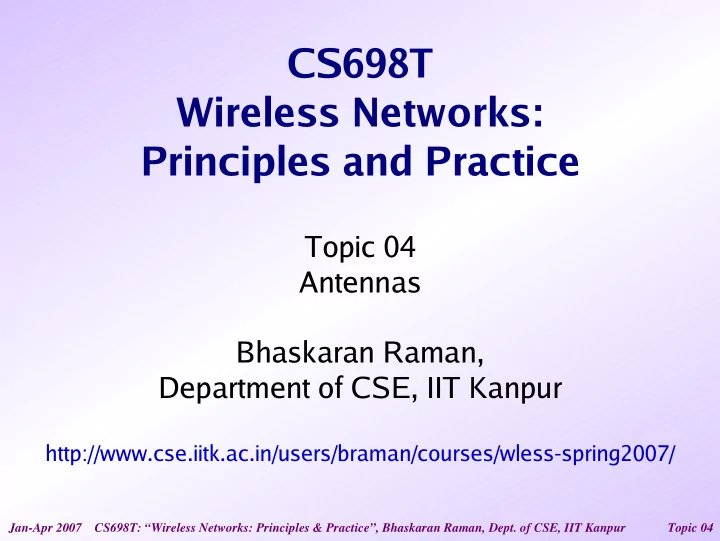

CS698T Wireless Networks: Principles and Practice Topic 04 Antennas Bhaskaran Raman, Department of CSE, IIT Kanpur http://www.cse.iitk.ac.in/users/braman/courses/wless-spring2007/ Jan-Apr 2007 CS698T: “Wireless Networks: Principles & Practice”, Bhaskaran Raman, Dept. of CSE, IIT Kanpur Topic 04
Antenna Gain Antenna Gain G: ratio of transmit/receive power in a particular direction, to that of an isotropic antenna G = P directional P isotropic Transmit gain == Receive gain Typically, gain is expressed in dBi 2 A eff = G r × 4 × Jan-Apr 2007 CS698T: “Wireless Networks: Principles & Practice”, Bhaskaran Raman, Dept. of CSE, IIT Kanpur Topic 04
Antenna Radiation Pattern 0dB -3dB Side-lobe 90 o Parabolic Grid -10dB rejection -20dB Antenna levels -30dB 0 o 180 o Main direction Side-lobes Half-power beam-width 270 o = 8 deg Other antennas/patterns: http://www.hyperlinktech.com/ Jan-Apr 2007 CS698T: “Wireless Networks: Principles & Practice”, Bhaskaran Raman, Dept. of CSE, IIT Kanpur Topic 04
Some Antenna Terms ● Horizontal vs. Vertical radiation pattern ● Antenna names: – Directional, Sector, Omni ● Mechanical specifications (for mounting): dimensions, weight, temp. range, wind loading ● Electrical specifications: impedance, input power Jan-Apr 2007 CS698T: “Wireless Networks: Principles & Practice”, Bhaskaran Raman, Dept. of CSE, IIT Kanpur Topic 04
Frii's Free-Space Formula, with Antenna Gain Terms 2 P r = P t × G t × G r × 4 ×× d Some more useful forms of the Frii's formula: 2 Free-space c P r = P t × G t × G r × 4 ×× f × d path-loss P r dBm = P t dBm G t dB G r dB - [ 32.5 20log 10 f 20log 10 d ] where f is in MHz and d is in km Effective Isotropic Radiated Power (EIRP) http://www.seattlewireless.net/index.cgi/InterpretingFccRegulations Jan-Apr 2007 CS698T: “Wireless Networks: Principles & Practice”, Bhaskaran Raman, Dept. of CSE, IIT Kanpur Topic 04
EIRP Regulations: P2MP Links For Point-to-Multipoint links, EIRP = 36 dBm (2.4 Ghz, FCC, USA) Maximum Allowable Example Example Legal Radio Output Antenna Gain Radios Antennas Omnis, Sectors, Panels, 15dBm (30mW) 21dBi Orinoco, Yagis, Low end parabolics Omnis, some sectors, 20dBm (100mW) 16dBi Cisco, some yagis, some panels 23dBm (200mW) 13dBi Senao, Most omnis, some panels 1/2 watt Some omnis, some 27dBm (500mW) 9dBi Amp patches 30dBm (1 watt) 6dBi 1 watt Amp Some omnis Source: http://www.seattlewireless.net/index.cgi/InterpretingFccRegulations Jan-Apr 2007 CS698T: “Wireless Networks: Principles & Practice”, Bhaskaran Raman, Dept. of CSE, IIT Kanpur Topic 04
EIRP Regulations: P2P Links For Point-to-point links, 2.4 dBi dBm EIRP in dBm GHz, FCC, USA 6 30 36 ● EIRP is 36dBm for 6dBi 9 29 38 antennas ● For every additional 3 dBi, 12 28 40 max. transmit power is 15 27 42 reduced by 1 dBm 18 26 44 21 25 46 24 24 48 27 23 50 30 22 52 ... ... ... Source: http://www.seattlewireless.net/index.cgi/InterpretingFccRegulations Jan-Apr 2007 CS698T: “Wireless Networks: Principles & Practice”, Bhaskaran Raman, Dept. of CSE, IIT Kanpur Topic 04
EIRP Regulations in India ● For 2.4 GHz, likely the same as in FCC (USA) ● See: – Ministry of Communications and Information Technology, Wireless Planning and Coordination Wing NOTIFICATION New Delhi, the 28th January, 2005 – Gazette-2.4GHz-Outdoor.doc Jan-Apr 2007 CS698T: “Wireless Networks: Principles & Practice”, Bhaskaran Raman, Dept. of CSE, IIT Kanpur Topic 04
Antenna Polarization ● Polarization: the orientation of the E-plane (electric field) ● Tx and Rx antenna should use the same polarization – 45 deg mismatch ==> 3 dB loss – 90 deg mismatch ==> up to 20 dB loss Jan-Apr 2007 CS698T: “Wireless Networks: Principles & Practice”, Bhaskaran Raman, Dept. of CSE, IIT Kanpur Topic 04
Near Field and Far Field 2 P r = P t × G t × G r × 4 ×× d D is the largest Valid only when dimension of 2 d d f = 2 × D the antenna Near field Far field D = 1m Example: what is the near-field of the f = 2.4 GHz parabolic grid antenna shown earlier? 2 d f = 2 × 1 0.125 = 16m Jan-Apr 2007 CS698T: “Wireless Networks: Principles & Practice”, Bhaskaran Raman, Dept. of CSE, IIT Kanpur Topic 04
Path Loss Example d P t P r P t = 50mW , 2.4GHz transmission ,d = 2km ,P r = ? PathLoss = 32.5 20log 10 2400 20log 10 2 ≃ 106dB P r = P t - PathLoss = 17dBm - 106dB = - 89dBm G t = 24dBi ,G r = 24dBi ,P r = ? - 89dBm 24dB 24dB = - 41dBm Jan-Apr 2007 CS698T: “Wireless Networks: Principles & Practice”, Bhaskaran Raman, Dept. of CSE, IIT Kanpur Topic 04
A Simple Antenna Design 4 4 Radiation Dipole Antenna Pattern Jan-Apr 2007 CS698T: “Wireless Networks: Principles & Practice”, Bhaskaran Raman, Dept. of CSE, IIT Kanpur Topic 04
Recommend
More recommend